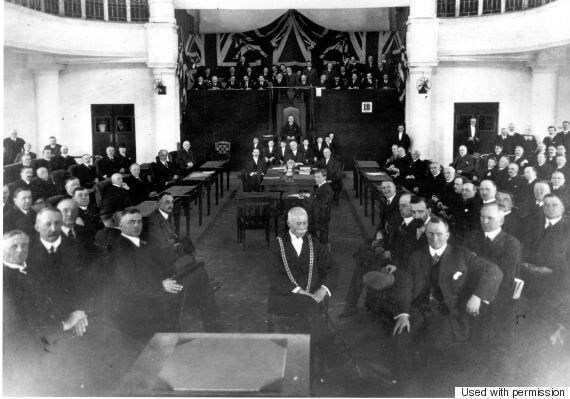
Imagine this page from American history:
At a time of World War, Congress is in full debate on a cold and windy February evening. A note is handed to the Speaker of the House, leading him to pound his gavel and call his fellow representatives to immediate order.
"We must leave urgently..." he implores. Within two hours of the lawmakers' hasty departure, the entire capitol building is engulfed in flames, visible for miles by residents in the adjacent states of Virginia and Maryland. By the next morning the domed building is a charred shell, damaged far beyond the havoc wrought by the British a hundred years earlier during the War of 1812.
But the nation's business could not be put on hold -- it was, after all, wartime. Within a day Congress has relocated to the Smithsonian Institution, just down Pennsylvania Avenue. Galleries were closed; dinosaurs and natural history displays moved to the side; room was made for both the House and Senate.
For four years this would be the new home for Congress -- momentous years that include the passage of military conscription (the "draft"), the Income Tax and legislation that led to passage of the 19th Amendment, granting women the right to vote.
If you think you missed this in your history books, you're right. It is not U.S. history. If it had been, chances are we Canadians would all have learned about it from Broadway plays, Hollywood movies, mournful ballads and PBS American Experience broadcasts. It would have dwarfed the tale of Dolly Madison rushing from a burning White House with a painting or two.
It is actually a page from Canadian history, and has been understated and under-hyped -- history just the way we like it.
But should we like it that way?

On Feb. 3, 1916, a fire started in the House of Commons' reading room (perhaps by an errant cigar) and quickly took hold. The centre block of Canada's Parliament building -- housing both the Senate and the Commons -- effectively burned to the ground. It was windy and cold -- it was Ottawa in winter after all -- and attempts to quell the flames were fruitless as fire hoses froze.
Seven people died in the flames, including a member of Parliament, a policeman, several staffers and two visitors. The only saving grace was the preservation of the Library of Parliament by a quick-thinking employee who shut the heavy doors between the adjacent buildings.
What happened next was truly amazing. Remember, Canada was in the throes of the First World War, or the Great War as it was known at the time. America had not yet entered and Canada was a major factor in the conflict, vital to Britain and France's chances of success. Canada needed to stay in the game.
Just a mile away stood Canada's newly opened national museum -- today the Museum of Nature -- and within a day, its dinosaurs and other artifacts were (gently) thrust aside and Parliament was back in business. The museum's theatre became the House of Commons, the mineral gallery the Senate. (And, yes, both seem fitting.) Canada never missed a beat.
I recently asked Margaret Beckel, president and CEO of the Canadian Museum of Nature, to reflect on what happened in her building 100 years ago:
"It is nice to think that the work we carried out back then, utilizing a great building, contributed to preserving our country during a devastating World War. I would like to think the work we do today -- in the Arctic, species discovery and preservation of biodiversity -- is equally important, not only to Canada, but the world."
Should you happen to visit the Canadian Museum of Nature in the days ahead, look for a small plaque that reminds visitors that the museum doors were, for four years beginning 100 years ago, the entry way to a productive and effective Parliament. Some cynics might say we should move Parliament back to the museum to see if we can get the same result -- I would simply say we should properly recall the effort.
Follow HuffPost Canada Blogs on Facebook
MORE ON HUFFPOST: